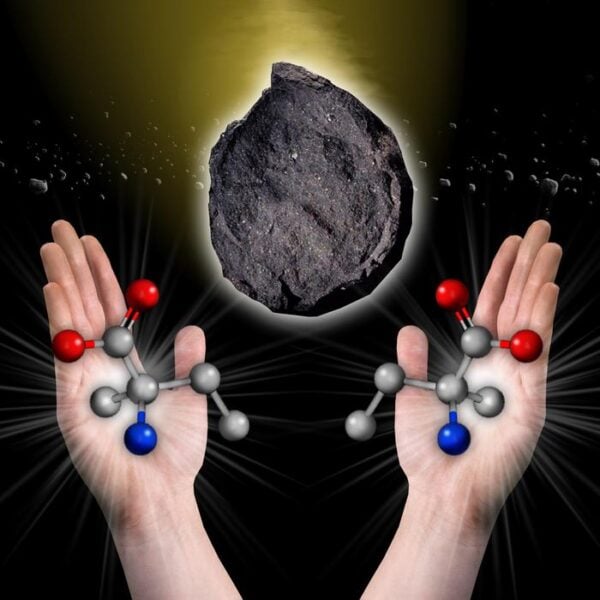In a finding that deepens one of biology’s most persistent mysteries, NASA-funded scientists have discovered that RNA – a molecule central to life’s origins – shows no inherent preference for creating left-handed or right-handed protein building blocks. This unexpected revelation challenges long-held assumptions about how life’s fundamental molecular preference emerged.
Published in Nature Communications | Estimated reading time: 6 minutes
Life has a peculiar preference: it exclusively uses left-handed amino acids to build proteins, despite right-handed versions being equally possible. This one-sided choice, known as homochirality, has puzzled scientists seeking to understand life’s origins. Just as your left and right hands are mirror images of each other, amino acids can exist in two mirror-image forms. Yet somewhere in the distant past, life made an exclusive choice for the left-handed variety.
Many scientists theorized that RNA, which likely preceded DNA in early life, might have naturally favored creating left-handed amino acids, thus setting life’s path. RNA can both store genetic information and catalyze chemical reactions, making it a prime candidate for life’s first molecular architect. This “RNA world” hypothesis suggests that RNA preceded the more complex DNA-based systems we see in modern cells.
However, new research led by UCLA’s Irene Chen reveals a more complex picture. “The experiment demonstrated that ribozymes can favor either left- or right-handed amino acids, indicating that RNA worlds, in general, would not necessarily have a strong bias for the form of amino acids we observe in biology now,” explains Chen.
The team tested 15 different RNA molecules that act like enzymes (ribozymes) under conditions mimicking early Earth. These molecular craftsmen were put to work creating the amino acid phenylalanine. Surprisingly, they showed no consistent preference – some favored left-handed amino acids, while others preferred right-handed versions. This lack of bias suggests that life’s preference for left-handed amino acids emerged through other means.
“The findings suggest that life’s eventual homochirality might not be a result of chemical determinism but could have emerged through later evolutionary pressures,” notes co-author Alberto Vázquez-Salazar. This insight opens new questions about how and why life made its molecular choice.
The implications extend beyond Earth. Scientists are actively searching for signs of life elsewhere in our solar system, and understanding molecular handedness could provide crucial clues. Jason Dworkin, senior scientist at NASA’s Goddard Space Flight Center, connects the finding to current space exploration: “We are analyzing OSIRIS-REx samples for the chirality of individual amino acids, and in the future, samples from Mars will also be tested in laboratories for evidence of life including ribozymes and proteins.”
This research gains additional significance when considering that amino acids have been found in meteorites, suggesting that life’s building blocks may have arrived from space. The asteroid Bennu, recently sampled by NASA’s OSIRIS-REx mission, could provide new insights into the distribution of left- and right-handed molecules in our solar system.
As scientists continue to analyze samples from space and conduct laboratory experiments simulating early Earth conditions, the mystery of life’s molecular handedness remains. While we now know that RNA didn’t predetermine this choice, the quest to understand how and why life chose its molecular orientation continues to drive exploration both on Earth and beyond.
Glossary:
- Homochirality
- The use of only one mirror-image version of molecules in biological systems, like exclusive use of left-handed amino acids in proteins.
- Ribozyme
- An RNA molecule that can act as an enzyme, catalyzing chemical reactions.
- Chirality
- The property of a molecule existing in mirror-image forms, similar to how left and right hands mirror each other.
Why is the exclusive use of left-handed amino acids in life considered mysterious?
Because right-handed versions would work equally well, making life’s exclusive choice of left-handed versions puzzling.
What was the key finding of this NASA-funded research?
RNA molecules (ribozymes) can favor creating either left-handed or right-handed amino acids, showing no inherent preference for left-handed versions used in life today.
What is the RNA world hypothesis?
The idea that RNA preceded DNA in early life, acting both to store genetic information and build proteins.
How might this discovery impact the search for extraterrestrial life?
It influences how scientists analyze samples from space missions like OSIRIS-REx and future Mars missions for signs of life.
Enjoy this story? Subscribe to our newsletter at scienceblog.substack.com
If our reporting has informed or inspired you, please consider making a donation. Every contribution, no matter the size, empowers us to continue delivering accurate, engaging, and trustworthy science and medical news. Independent journalism requires time, effort, and resources—your support ensures we can keep uncovering the stories that matter most to you.
Join us in making knowledge accessible and impactful. Thank you for standing with us!

